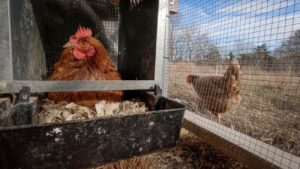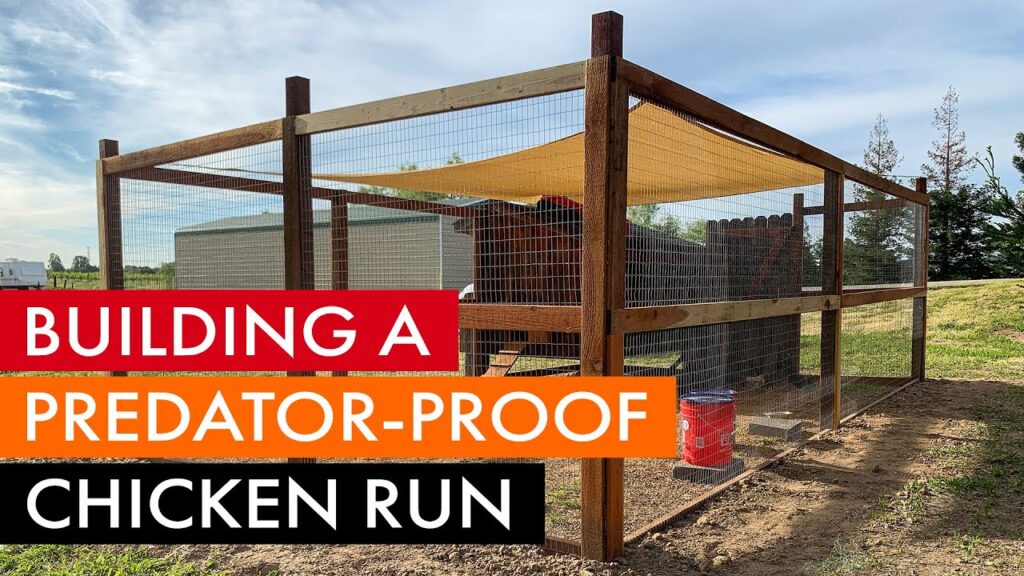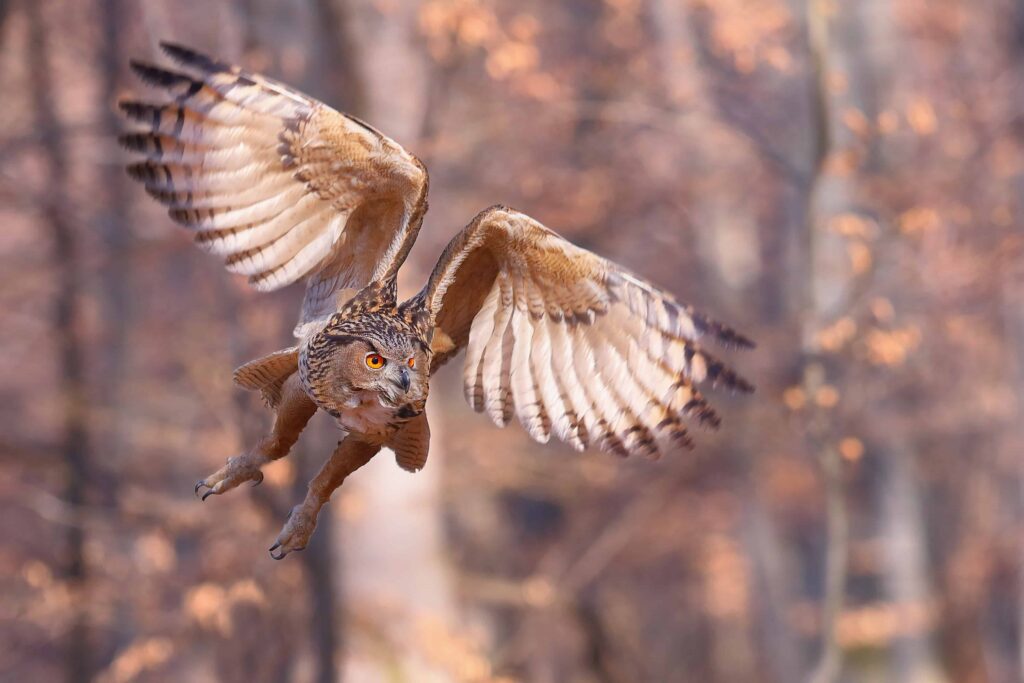Last updated on August 6, 2025
Finding a pile of feathers where a hen used to be, or seeing a shadow slip away at dusk, is a poultry keeper’s worst nightmare. Foxes, coyotes, and wild dogs are intelligent, adaptable, and highly motivated hunters. They pose a significant threat to backyard flocks.
As a poultry farmer in Nigeria, I’ve dealt with over 7 fox attacks in 3 years, learning firsthand the importance of robust defenses. Protecting chickens from predators isn’t about a single “magic bullet” solution. It’s about creating multiple layers of security. This guide gives you the exact checklist, materials, and setup used by real farmers to stop foxes and coyotes — permanently. Here’s how you can safeguard your flock with a fortress-building strategy.
These predators are some of the most common threats, which we cover in our main guide to Chicken Predators & Protection.
Understanding the Threat: Know Your Enemy’s Tactics
To effectively protect your flock, you need to understand the behavior of these cunning canine predators. Knowing their tactics is your first line of defense.
The Fox: The Cunning Opportunist
Foxes are incredibly intelligent and opportunistic. They climb, dig, and exploit any weakness in your defenses.
They’re most active at dawn and dusk, but can you protect chickens from foxes during the day? Yes, foxes do eat chickens in the day, especially when they have kits (young) to feed in the spring.
You might also wonder, why do foxes kill chickens and leave them? This is known as “surplus killing” or “cache hunting.” As Wildlife Online explains, “In a chicken coop or small garden the birds are contained and continue to flap in panic, causing the fox’s prey drive to be continuously triggered until the stimulus is gone (i.e. all the birds are dead).” Foxes instinctively kill when the opportunity arises, often intending to return later to cache (bury) the food.
The Coyote: The Powerful Hunter
Coyotes are larger and more powerful than foxes. They have incredible strength and agility.
How high can coyotes jump? They jump surprisingly high. Sheldon Owen, a wildlife extension specialist at West Virginia University, states, “Coyotes are good climbers and can scale a 6-foot fence.” (Source: Southern Living). They may hunt alone, in pairs, or small family groups.
Will coyotes break into a chicken coop? Yes, they’re persistent. The Omlet Blog notes, “Notorious for being some of the most persistent of predators, coyotes will dig, scratch, bite, and push their way into many standard chicken enclosures.” (Source: Omlet Blog US) They rip through weak wire and break flimsy latches. This shows the challenge of how to keep coyotes away from chickens.
Signs of an Attack: How to Identify the Culprit
Identifying the predator helps you refine your defenses. This section covers Signs of fox killing chickens.
Foxes: Often leave a pile of feathers. They may take just the head or carry the whole bird away. Their tracks are small and dog-like, in a straight line.
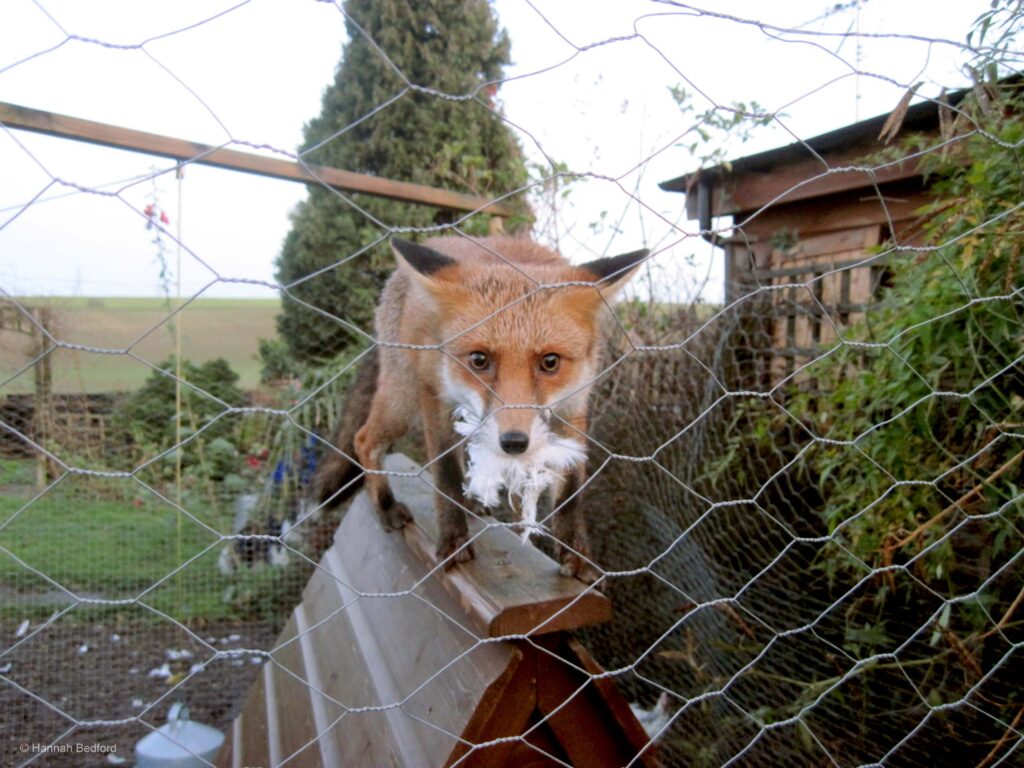
Coyotes/Dogs: More likely to create a messy scene with widespread feathers and potentially dismembered birds. Their tracks are larger than a fox’s, resembling those of a medium-sized dog.
Your First and Best Defense: A Predator-Proof Fortress
Building a secure coop and run is your most critical step. This section guides you on how to keep foxes out of chicken coops.
The Most Common Mistake: Why Chicken Wire Fails
Chicken wire is insufficient for predator protection because it’s designed to keep chickens in, not predators out. Can chicken wire keep coyotes out? The answer is a resounding NO. Chicken wire’s wide openings let predators easily tear it, and foxes can bite through it with little effort.
The solution is to install 1/2-inch galvanized hardware cloth as the minimum standard for all walls, windows, and vents. Hardware cloth is a woven or welded wire mesh made from heavier gauge wire than chicken wire, with small, typically square or rectangular openings (like 1/2-inch or 1/4-inch). This tight mesh and strong build resist chewing, tearing, and squeezing by predators.
As ImaginAcres emphasizes, “Hardware cloth is much stronger and more durable than chicken wire… Its thicker gauge wire and tighter mesh make it resistant to penetration and damage from predators.” (Source: ImaginAcres) I learned this the hard way when a persistent fox squeezed through a tiny gap in my chicken wire run, prompting an immediate upgrade to hardware cloth that has kept my flock safe ever since. This is key to a truly fox-proof chicken coop.
The 360-Degree Security Checklist
Use this checklist to create an impenetrable haven for your flock. This answers What to put around a chicken coop to keep predators away?
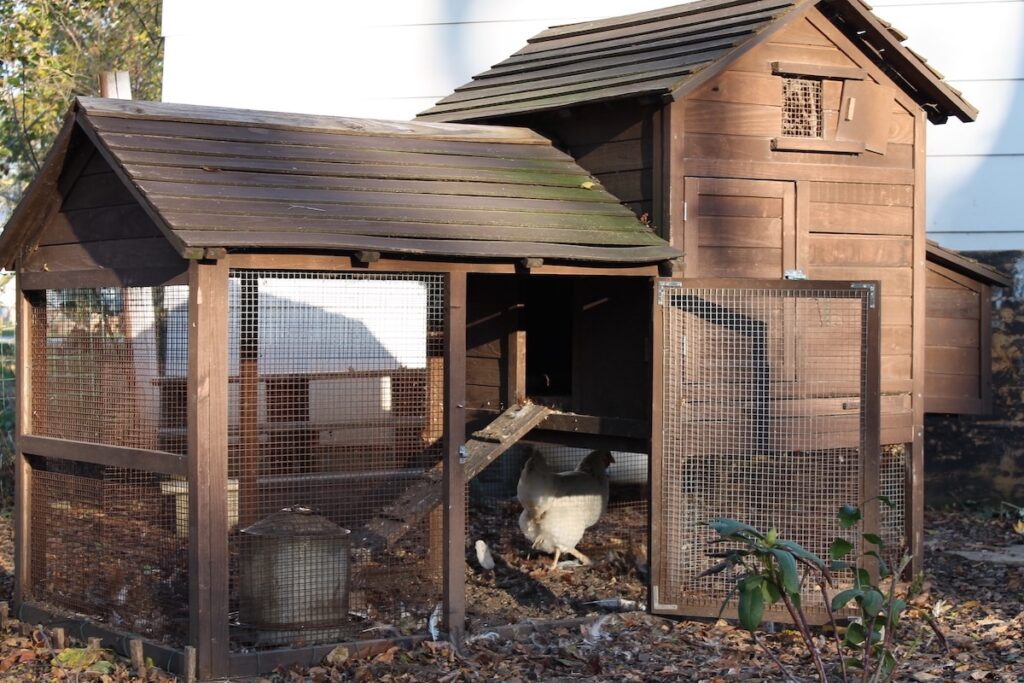
- The Roof: Your chicken run must be fully covered with a sturdy material like hardware cloth or welded wire. Foxes, coyotes, and wild dogs are excellent climbers and will scale fences to get in.
- The Floor (Stopping the Dig): This covers What animal will dig under a chicken coop? Foxes, coyotes, and wild dogs are all skilled diggers. Implement the “apron” method:
- Dig a trench around the entire perimeter of your coop. This trench should be at least 12 inches deep and 12 inches wide.
- Lay down hardware cloth into the trench. The hardware cloth should be wide enough to go vertically down the coop wall into the trench, then bend outwards horizontally for another 12-24 inches away from the coop. This creates an “L” shape.
- Secure the hardware cloth to the bottom edge of your coop walls using heavy-duty staples, screws with washers, or zip ties. Overlap seams by several inches and secure them tightly.
- Backfill the trench with soil, ensuring the hardware cloth is completely buried. This hidden barrier prevents digging predators from tunneling directly into your coop or run.
- Doors & Latches: Install two-step locking mechanisms (e.g., a sturdy latch combined with a carabiner clip) that require more dexterity than a predator possesses. Simple latches can often be opened by clever paws. For more tips on securing your coop, check out our guide on Raccoon-Proof Chicken Coops.
For more detailed instructions on securing your coop, this is the perfect spot to link to your more detailed article: DIY Predator Proof Your Chicken Coop.
Adding Layers of Defense: Deterrents and Repellents
Beyond physical barriers, you can add layers of deterrents. Be honest about their effectiveness; they’re supplementary, not primary, defenses. This section covers what will keep foxes away from chickens and how to keep coyotes away.
Sensory Deterrents: Light and Sound Tactics
These tactics aim to startle or confuse predators like foxes, coyotes, and wild dogs. They address how to scare foxes away from chickens and whether sounds like radios work.
- Motion-Activated Lights/Sprinklers: These are highly effective as a surprise tactic. A sudden burst of light or water can send a cautious predator fleeing. This is a good way to how to scare foxes away from chickens. For example, one poultry keeper shared how installing a motion-activated sprinkler near their coop drastically reduced nighttime visits from a persistent fox, as the sudden spray of water was enough to send it running every time.
- Predator Eye Devices: Small, solar-powered lights that mimic the glowing eyes of another predator can create the illusion of a larger animal watching. These can be effective against curious foxes and coyotes.
- Radios: A talk radio station left on at low volume can create the illusion of human presence. However, intelligent animals like foxes and coyotes can get used to consistent sounds over time, reducing effectiveness. So, will a radio keep foxes away permanently? Not reliably.
Scent Repellents: Do They Work?
Many farmers ask whether scent repellents can deter foxes and coyotes. This includes questions like what smell do foxes hate? and what smells keep coyotes away? People also wonder, will cayenne pepper keep foxes away? or does human urine deter foxes? This also covers what can you spray to keep foxes away? and how to protect chickens from foxes naturally.
Most scent repellents have limited and temporary effectiveness against foxes, coyotes, and wild dogs. They rely on strong odors that dissipate quickly, especially after rain. They are not reliable long-term solutions.
- Commercial Repellents: Some commercial repellents containing predator urine (e.g., coyote urine for foxes) can sometimes create a sense of danger, acting as coyote deterrents for poultry.
- Questionable Home Remedies: While some people try human urine, ammonia, or cayenne pepper, their effectiveness is highly debated and wears off quickly. These are not reliable solutions and can even harm your birds or the environment if not used correctly.
The Ultimate Perimeter: Electric Fencing
Electric fencing, particularly electric poultry netting, is one of the most effective deterrents for a perimeter. Electric poultry netting is a portable, electrified fence specifically designed for poultry, with close-knit strands and a low-voltage shock that deters predators without harming them. It delivers a memorable, harmless shock that teaches predators like foxes, coyotes, and wild dogs to stay away. This provides a strong physical consequence that other deterrents lack. This is often the best way to control coyotes and foxes in larger areas.
Recruiting Help: Guardian Animals for Your Flock
Can other animals help protect chickens from foxes? This section explores What animals protect chickens from foxes? and Will a dog scare a fox away?
Livestock Guardian Dogs (LGDs): The Gold Standard
For serious predator pressure, Livestock Guardian Dogs (LGDs) are the gold standard. Livestock Guardian Dogs are specific breeds of dogs (like Great Pyrenees, Anatolian Shepherd, Akbash) that are instinctively bred to bond with and protect livestock from predators, often living full-time with the flock. They deter threats through their presence, barking, and direct confrontation.
LGDs are a serious commitment and a working animal, not a pet. They need specific training and bonding with the flock from a young age to be effective. Their presence adds a crucial living layer to your defense, working with your physical barriers to create a formidable deterrent system against foxes, coyotes, and wild dogs. For example, a farmer in rural Ohio recounted how their Great Pyrenees, Luna, successfully deterred a persistent coyote pack after several attempts to breach the coop. Luna’s constant vigilance and territorial barking proved invaluable in safeguarding the flock.
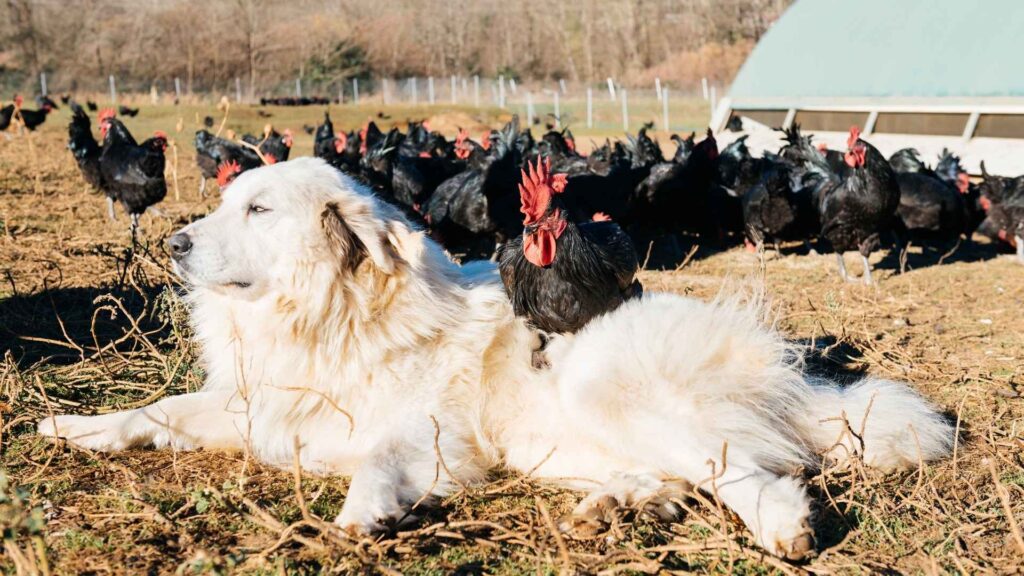
Other Guardians: Donkeys, Llamas, and Roosters
- Donkeys/Llamas: Some donkeys and llamas naturally hate and show aggression towards canids, making them effective deterrents in larger pastures. They can help deter foxes, coyotes, and wild dogs.
- Roosters: A rooster acts as an “alarm system,” alerting the flock to danger and bravely confronting smaller threats. However, they are not a physical match for a determined fox or coyote and will likely be killed in a direct confrontation. So, will a dog scare a fox away effectively? Only if it’s a dedicated LGD.
Common Mistakes to Avoid in Predator Protection
Even with the best intentions, common errors can leave your flock vulnerable. Being aware of these pitfalls can significantly strengthen your defenses.
Overlooking Small Openings
It’s easy to focus on obvious entry points, but predators are incredibly resourceful. Even the smallest gaps can be exploited. A common mistake is thinking a hole is too small for a predator. For instance, weasels can squeeze through openings as small as one inch, and a determined fox can widen a seemingly tiny crack. Regularly inspect your coop and run for any new holes, loose wire, or gaps around doors, windows, and vents. If you can fit your thumb through it, a predator can likely get in.
Inadequate Fencing
Relying on the wrong type of fencing is a frequent and costly mistake. As discussed earlier, chicken wire is insufficient for predator protection. It’s designed for containment, not defense. Predators like foxes and coyotes easily chew through or tear open chicken wire. Always opt for 1/2-inch galvanized hardware cloth for all coop and run construction. This material’s strength and small mesh size are crucial for truly deterring digging and chewing predators.
Maintenance Schedule: Ensuring Ongoing Protection
Building a predator-proof coop is a great start, but ongoing vigilance is key. Regular maintenance ensures your defenses remain strong against persistent foxes, coyotes, and wild dogs.
Weekly Tasks
- Inspect the Coop and Run: Walk around the entire perimeter of your coop and run. Look for any signs of wear and tear, like loose hardware cloth, bent wires, or new holes. Pay close attention to the base where predators might try to dig.
- Check for New Holes or Gaps: Predators are constantly testing your defenses. Look for fresh dig marks, disturbed soil, or any small openings that may have appeared due to weather or animal activity.
- Verify Latches and Locks: Make sure all doors and access points work properly and that latches are securely fastened. A quick jiggle confirms they’re still predator-proof.
- Clean Up Spilled Feed: Remove any spilled chicken feed from around the coop and run. This prevents attracting rodents, which in turn attract foxes, coyotes, and wild dogs.
Seasonal Tasks
- Reinforce Before Extreme Weather: Before winter freezes or heavy rainy seasons, check for any weak spots that could be made worse by weather. Reinforce structures, repair any worn areas, and make sure drainage is adequate to prevent undermining the coop’s foundation.
- Update Deterrents: If using motion-activated lights or sprinklers, check their batteries and functionality. Reposition them if you notice new approach patterns from predators. For scent-based repellents, reapply them regularly as their effectiveness lessens over time, especially after rain or snow.
- Trim Vegetation: As seasons change, vegetation around your coop might grow denser. Trim back tall grasses, bushes, and any overgrown areas that could provide cover for predators. A clear perimeter makes your coop less appealing as a hunting ground for foxes, coyotes, and wild dogs.
When Deterrents Fail: How to Get Rid of a Fox or Coyote
How do I get rid of foxes permanently? This is a complex question. This section also covers how to get rid of a fox killing chickens and how to get rid of foxes and coyotes?
Warning: Before attempting to trap or dispatch any wildlife, you MUST check your local, state, and federal laws. Regulations vary significantly, and what is legal in one area may be illegal in another. Contact your local wildlife agency or animal control for guidance. As a wildlife control officer from [Your Local Wildlife Agency, e.g., Lagos State Parks and Wildlife] might advise, “Understanding local regulations is paramount. Unlawful trapping or removal can lead to fines or harm to non-target species.”
The Reality of “Permanently”: Removing one animal often just opens up the territory for another, younger, or less experienced predator to move in. The only truly “permanent” solution is making your property so impenetrable and unattractive that predators have no reason to visit. This also applies to how to keep foxes away from your house.
Last Resort Options: If all prevention fails and you have a persistent problem, you may consider humane trapping (stressing the need for humane traps and adherence to laws) or contacting professional wildlife removal services. These should be considered absolute last resorts after all preventative measures have been exhausted.
Frequently Asked Questions (FAQ)
Q1: How do I keep chickens safe from foxes and coyotes at night?
A: The single most important thing is a secure coop with a predator-proof latch, locked every single night without fail.
Q2: What is the most effective deterrent for foxes and coyotes?
A: No single repellent is foolproof. A multi-layered approach is best, but a properly installed electric fence is the most effective physical deterrent for these canids.
Q3: How to protect chickens from foxes and coyotes during the day?
A: A secure, fully enclosed run with a top cover is essential. Never let chickens free-range completely unsupervised if foxes or coyotes are in the area.
Q4: What are the signs of a coyote or wild dog attack on chickens?
A: These attacks often result in a messy scene with scattered feathers and potentially missing or dismembered birds. Large, dog-like tracks may be present.
Q5: Can a regular dog guard my chickens from foxes or coyotes?
A: Most regular dog breeds are not suitable as Livestock Guardian Dogs. They may play with or even harm chickens, and need extensive training to be reliable guardians against these predators.
Q6: How deep should I bury hardware cloth to stop foxes, coyotes, and wild dogs from digging?
A: Bury hardware cloth at least 12 inches deep and extend it outwards horizontally for another 12-24 inches to create an effective apron against digging predators.
Q7: What sounds deter foxes and coyotes?
A: Motion-activated alarms or radios playing talk radio can deter them initially, but foxes and coyotes may get used to consistent sounds over time.
Q8: What animals can help protect chickens from foxes and coyotes?
A: Livestock Guardian Dogs (LGDs) are specifically bred to deter these predators. Donkeys and llamas can also be effective guardians in certain settings.
Q9: How do I get rid of foxes or coyotes permanently?
A: Removing one animal often just opens the territory for another. The only truly permanent solution is making your property so impenetrable and unattractive that these predators have no reason to visit.
Conclusion
How to protect chickens from foxes, coyotes, and wild dogs is an ongoing process that needs vigilance and a multi-layered approach. By focusing on a physically secure coop (using hardware cloth, a buried apron, and a covered run), using various deterrents (lights, sounds, and potentially electric fencing), and understanding the roles of guardian animals, you can significantly reduce the risk of predator attacks. This combination of strategies creates a robust defense.
Protecting your flock is an ongoing process, but with these strategies, you can build a safe haven and coexist with local wildlife. What are your most effective strategies for keeping foxes and coyotes away? Share your experience in the comments below! We’d love to hear your success stories and practical advice.
